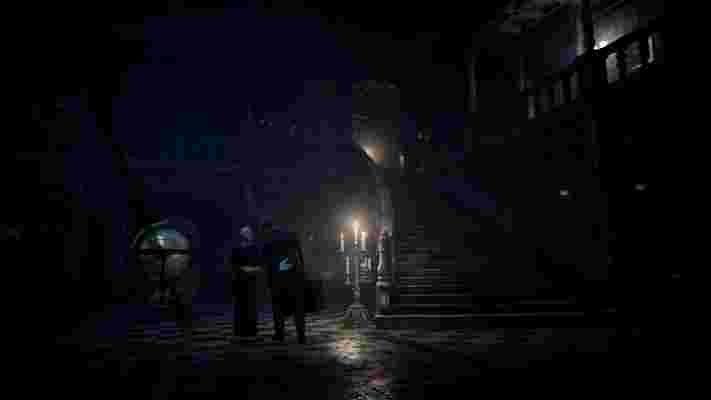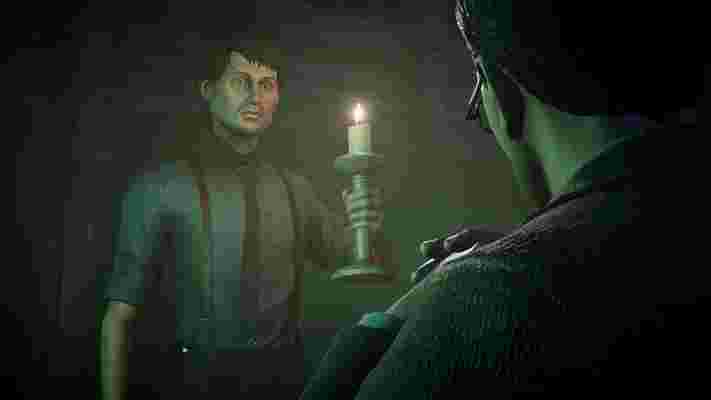Original article provided by 4players.de
In August, adventure fans got not one, but two reasons to be happy: not only was a remake of the classic Black Mirror announced , the experienced Bremen studio King Art (Book of Unwritten Tales) was tasked with developing the title. Best conditions for psychological horror in a remote Scottish mansion? Or should we expect a shaky quality control by publisher Nordic, as we had with The Ravenan?
Mechanical entry hurdles
After three installments, Black Mirror was not continued, but rather it was decided to “reboot” the tragic story of the Gordon family. As the series’ new protagonist, David Gordon has to deal with the mysterious events taking place in Black Mirror Castle and find out whether a curse is on his family. Already from the intro, the horror unfolds during a hectic escape – but not in the way the developers intended. Three are the scary things here: the wacky controls, the stiff character animations and the strange camera direction, which can be influenced a little bit with the right stick. Wait a minute, with the stick? Exactly, because the multi-platform title is primarily designed for navigation with the controller . There is also a mouse and keyboard version on the PC, but it looks like a makeshift model because you move the cursor with WASD directly rather than clicking on targets, especially since – annoyingly – you can only interact with hotspots near the character.

Therefore, after a short time, I switched back to the controller. But even so, the fiddly handling reminds me of the dark side of an early Resident Evil. In spite of the 3D engine , the perspective changes back and forth while exploring the property – which doesn’t exactly help with the overview. To make matters worse, the slow-moving figures also get stuck on various edges, only to then stumble, stiffly or twitchingly, around corners. Not even the simple mouth movements remind of a finished game. THQ Nordic and King Art have already published another title too early. However, fatal bugs like in The Raven were not to be found this time around. Although the adventure feels like maneuvering a log, the game functions.
Inheritance or curse?
Normally, it wouldn’t, of course, be natural to start the review of an adventure title with such technical intricacies, but here it simply fits the experienced dramaturgy, which in the first few minutes is still too permeated by the anger at the technical shortcomings. As soon as you get halfway settled, the trip to remote Scotland reveals that there are also some entertaining aspects: the inhabitants of the house are not very talkative or behave in a way you wouldn’t expect from someone who just experienced such tragic events. Nevertheless, their private secrets and the mystery around the alleged curse can build up a little tension.

Why does David, who has come from India, suffer from increasingly strong visions in which former inhabitants of the house seem to walk through the corridors? Has he been here before as a child? What clues did his late father want to give him through the encrypted documents? As the presumed heir to the mansion, David not only has to deal with the delusion that apparently struck the late owner shortly before his end but also with the remaining inhabitants of the house. These include Lady Margaret, a lawyer in charge of the estate, the stoic butler and a frightened housekeeper who apparently has secrets to hide. Later, David is joined by a companion, his doctor Leah, who is, however, an NPC. Instead, in the role of the protagonist, one searches through the property, which is visually very well staged.
Secrets between the paneling
Between gnarled wooden pores and the walls, ravaged by the harsh weather, all kinds of detailed desks, models and other nifty details are to be discovered, which are sometimes too dimly lit and also play an important part in the puzzles. For instance, one can presumably imagine what role the broken piece of a miniature of the property plays. A highlight is the mechanisms and secret compartments built into the furniture. Just like in The Room, a cozy puzzling mood really settles in when you take a closer look at all the corners of a chest of drawers to unlock decorations and runes so that you can open a new compartment with a single click. Although there are far less complicated mechanisms at work here, the mathematical tasks or the interpretations of found letters are still motivating.
However, it’s a bit of a pity that you’ll only come across so few puzzles in just over six hours . Compared to older King Art adventures, the density of puzzles has dropped considerably and in this respect, you are also somewhat behind competing titles such as Syberia 3 or Silence. Black Mirror’s “restart” is conceptually located somewhere between the very story-heavy Telltale principle and classic point-and-click adventures. Some puzzles have alternative solutions, e.g., by blackmailing the butler with the knowledge of his illegal hunting practices and thus getting the key to the cellar. The quality of the sound varies during such dialogues: sometimes you are delighted with the professional performance of the voice actors, elsewhere it sounds as if the recording director had been satisfied with the first, badly accentuated take. Musically, the adventure is very reserved : in hectic moments, the orchestral sounds swell dramatically, but apart from that, it is limited to stylistic devices such as soft surfaces, a deep humming or hissing which underline the ominous mood.
Annoying reaction tests
The reaction tests in David’s visions, in which one wanders unaware through the picture at first, also seem rather weak. Once you have recognized the principle, however, it is far too easy to hit the necessary interaction points – unless you get stuck somewhere again and have to go back to the last memory location or to the autosave. During David’s ghostly lapses, the picture distorts surreally and the player can learn more about the family’s and the property’s dark past by observing the shadowy figures.
On the normal PlayStation 4, you only have to live with small compromises compared to the PC , for instance with a slightly lower but stable frame rate. However, on the console’s standard model, the Xbox One implementation seems to be hurriedly thrown together. A lower resolution and lack of edge smoothing produce an ugly, unclean image, but these are the smallest problems. The framerate – which sometimes drops to about 15 fps – and the constant tearing of the picture right down the middle really gets on your nerves. Even if you take an object out of the small inventory to turn it around and examine it, it flickers with few frames. By the way, King Art has saved itself the trouble of offering a help function or a hotspot button. On the other hand, however, hints in dialogues and the quest log, in which the most important current tasks are brought to the point, help with getting started.
VERDICT
In conclusion, the reboot of Black Mirror is a reasonably creepy adventure, which suffers greatly from game mechanics such as the sluggish controls or the confused camera work. As soon as one gets used to the stiff stumbling around the mansion, the legends surrounding an ancient family curse make the player curious, especially as the puzzling with runes, secret doors and manipulated furniture offers some motivation. All in all, the short adventure lacks challenging puzzles . Presumably, King Art wanted to orientate itself more towards Telltale this time and has also implemented some (unsuccessful) reaction tests. In this way, however, it seems unlikely that the fascination of the classic from 2004 can be conveyed to new players.
